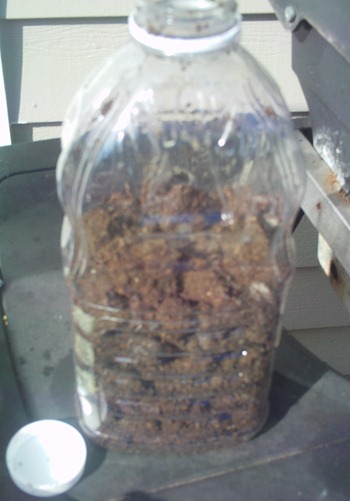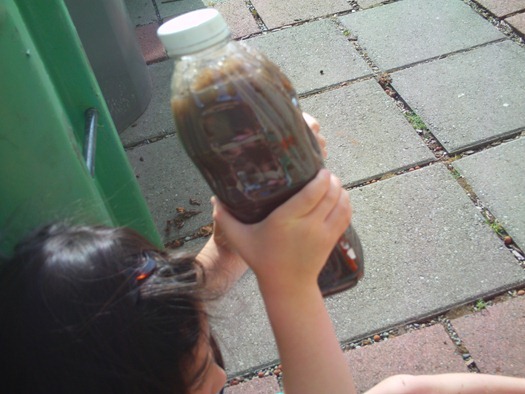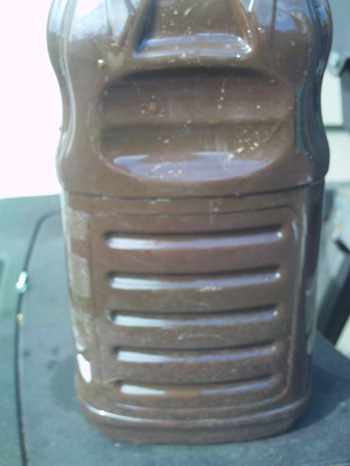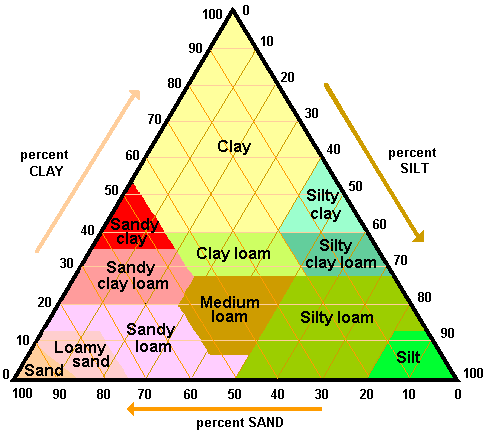Testing your garden soil
11.1 years ago nutrients, soil test

I always am good about amending my soil whether it is grabbing a bag of spent coffee beans from Starbucks whenever I notice them there, few handfuls of alfalfa pellets at the beginning of spring, or compost when it becomes ready in my bin. the thing I neglected to do was actually test my soil to see how I am doing.
The process to do this is actually pretty simple. You first start by getting a sample of your soil. If you have a very large garden it is a good idea to take multiple samples and mix them together for a single combined sample. What I decided to do was prepare my soil as if I was going to plant some seeds (turn up the soil with a claw, smooth it out, etc) then I took a sample about 6-7 inches deep and placed it in an old container than I am pretty sure held baby spinach.

Next comes the fun sciencey stuff, for the pH test you fill one of the cylinders to the first line with soil, add contents of one of the “green” capsules and fill to the fourth line with filtered/distilled water and shake vigorously.

For N/K/Potash tests the process is somewhat similar where you take one part soil to 4 parts water. For this I grabbed an old juice container from the recycling bin. Added the appropriately measured parts and shook for a good couple minutes, which was much more of a workout as the tiny vial… I then let the soil settle and came back 10 minutes later to see perlite floating on the surface and the water still a bit cloudy…think it was the coffee ground…

I then took a tea strainer, which I am pretty confident I have never used for straining tea, and poured some of the slightly cloudy water into a clean container to remove the perilite. I then filled each of the files to the appropriate (4th) line and added the color coded capsules to each of the vials. After 10 minutes of waiting I had my results…

So here is what I discovered:
- pH: Pretty much perfect, basically neutral maybe a bit on the acidic side but good range for most all vegetables
- Nitrogen: Though this shows a little color it started out a bit on the brown side so really this was almost no change so appears even with my amendments I am still very low on nitrogen.
- Phosphorus: Basically off the charts no need to add an more here…
- Potash: This one looks decent, probably could amend some here but really something I am worried about.
So for me this quick $4 soil test brought me some great information and will plant to give my garden some additional nitrogen boosts throughout the season.
How to find the soil composition of your garden
13.8 years ago science fair, soil composition, soil test
Knowing your soil composition is very important if you are attempting to amend your existing soil to get your premium soil for growing. You soil is made up of four components; sand, silt, clay, and organic material.
Sand has the largest particle size of all these components and creates large gaps between them which is excellent for water to flow through and roots to grow in. On the contrast it is terrible for retaining water and will dry out quickly.
Silt has medium size particles and if you had to choose a single component for effective growing this would be it. Its particles are large enough to allow healthy root growth and also retains water. Though some plants like their roots to be a little more on the drier side so in isolation this may not work for all plants
Clay has the smallest particles thus making it very difficult for water to flow through it. Not really much positive to say about this stuff though if your goal is to hold water this property can be great when used as a substructure out of your plants normal growing area 1-2 feet down, think of it as a natural earth box.
Organic Material is the good stuff (leaves, compost, grass clipping) the stuff that makes your “dirt” alive and becoming living soil. This feed beneficial bacteria and worms to provide rich vermicompost to add natural nutrients to your garden.
Now we know what we are looking for, lets find out what we have in our back yard. All of my vegetable gardens are raised which consist of soil I have brought in myself so I know they will be very loamy and high in organic matter to makes things more interesting.
1. Get Dirt: I dug a small hole (about 6 inches deep in a dead part of my lawn. I filled an apple juice container about 2/3 full. Any container can work for this as long as it is clear and uniform in shape/volume (width/depth) at the bottom.
2. Add Water and Shake: Fill with water about 1-2 inches from the top and shake for at least one minute to ensure particles are well mixed
3. Let Soil Components Rest: Set on a flat surface until water on top is clear or 24 hours (whichever comes first)
Before
After
4. Do the Math: After the dust particles have settled you should see 3 distinct lines and possibly some stuff floating in the water. The sediments will settle according to their particle size (sand, silt, clay) and organic material should float above the water.
Given the knowledge mentioned above we can now calculate the percentage of each soil component to determine our soil type take a couple simple measurements.
Total Soil Height = Measure from the bottom of the container to top of sand/silt/clay
Sand Height = Measure from bottom of container to top of sand
Silt Height = Measure from top of sand to top of silt
Clay Height = Measure from top of silt to top of clay
% Sand = Sand Height / Total Soil Height X 100
% Silt = Silt Height / Total Soil Height X 100
% Clay = Clay Height / Total Soil Height X 100
Example of math using my Data
69.47% Sand = 66mm / 95mm X 100%
29.47% Silt = 28mm / 95mm X 100%
1.05% Clay = 1mm / 95mm X 100%
Tip: You can measure with cm/mm/inches and the formulas will still work out as long as you use the same units for all measurements
Now using your Sand/Silt/Clay percentages you can now use the triangle diagram below to determine your soil type. Though it can vary depending on the types of plants you are growing (i.e. succulents like the sand) but in general a nice “Silty loam” is what you want to shoot for, so if you are lacking adding some organic matter is the best way to get moving in that direction
Image from http://web.bethere.co.uk/fm/soil/formed/f0107.htm
Using my data I have “Sandy Loam” soil, though if I would have dug a few inches deeper I would have had a much higher percentage of clay. Even if you are sure you know what your soil type I recommend trying this out you might end up surprised.



![002[4] 002[4]](http://www.cheapvegetablegardener.com/wp-content/uploads/2010/07/0024_thumb.jpg)



